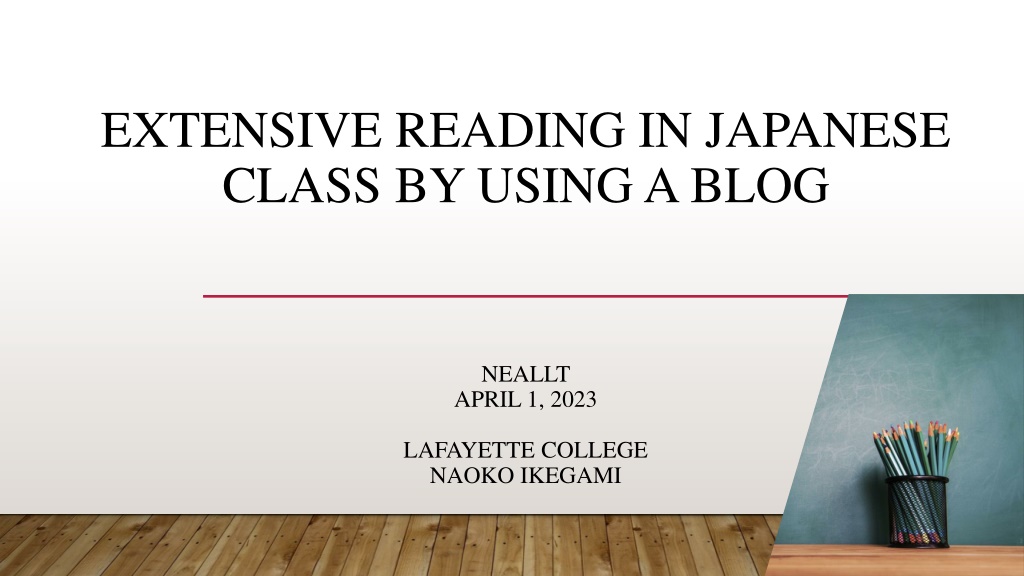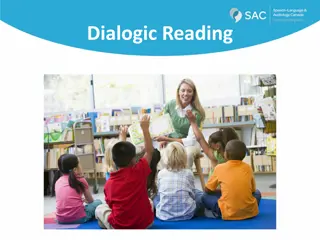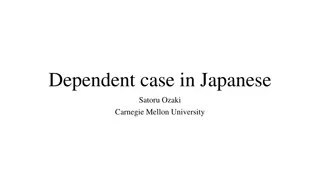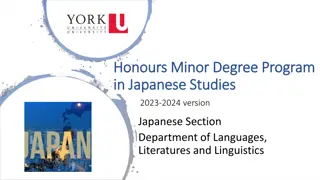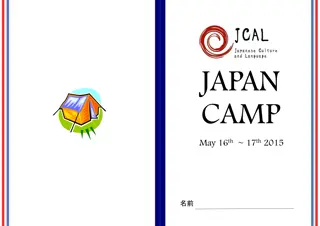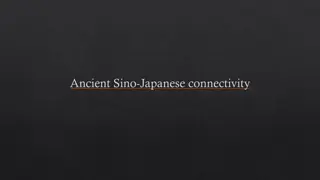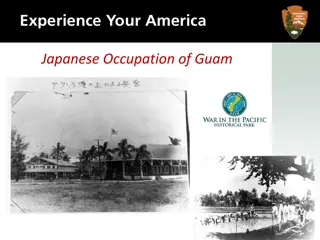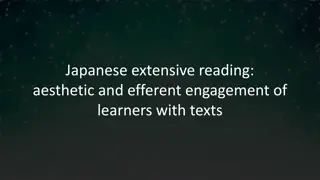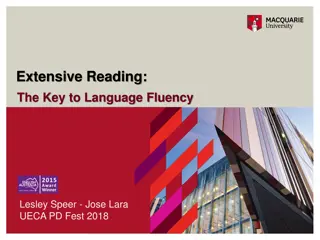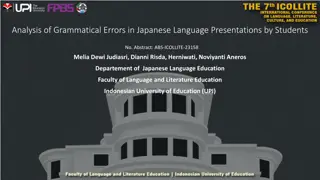Enhancing Japanese Language Learning Through Extensive Reading Blog
Explore the concept of extensive reading in Japanese language learning using a blog platform, focusing on providing students with easy access to diverse reading materials to improve their language skills. The blog offers various levels, audio support, and opportunities for independent reading practice, culminating in a structured assessment to gauge student progress.
Download Presentation

Please find below an Image/Link to download the presentation.
The content on the website is provided AS IS for your information and personal use only. It may not be sold, licensed, or shared on other websites without obtaining consent from the author. Download presentation by click this link. If you encounter any issues during the download, it is possible that the publisher has removed the file from their server.
E N D
Presentation Transcript
EXTENSIVE READING IN JAPANESE CLASS BY USING A BLOG NEALLT APRIL 1, 2023 LAFAYETTE COLLEGE NAOKO IKEGAMI
1. BACKGROUND Advanced level (Independent Study) in Fall 2022, after finishing Genki II Various interests but limited time What can students do outside of the classroom? Easy access, something fun and less pressure Open Educational Resources Blog tadoku (extensive reading) dojo (place to practice) Workshop in 2022 What is ,extensive reading? Ten principles in extensive reading (by Day & Bramford)
TEN PRINCIPLES PROVIDED BY DAY AND BAMFORD (2002) FOR SUCCESSFUL EXTENSIVE READING PROGRAM 1. Reading material is easy. 2. A variety of reading material on a wide range of topics must be available. 3. Learners choose what they want to read. 4. Learners read as much as possible. 5. The purpose for reading is usually related to pleasure, information and general understanding. 6. Reading is its own reward. 7. Reading speed is usually faster than slower. 8. Reading is individual and silent. 9. Teachers orient and guide their students. 10.The teacher is a role model of a reader.
2. THE BLOG ( CONTAINS MANY READING PASSAGES) TADOKU (EXTENSIVE READING) DOJO (PLACE TO HAVE A PRACTICE) Made by a Japanese Textbook Publisher called Kuroshio Press . Includes: 1) six levels (N1~N6) according to the Japanese Language Proficiency Test chart 2) all passages have pictures and illustrations 3) recorded audio (read by Japanese native voice actors) 4) Kanji (Chinese characters) are with furigana (Japanese sounds) sample page Open for public no membership fee or subscription. It s FREE Over 200 passages now and regularly added new passages index Grammar patterns, vocabulary and Kanji are considered by level
3. ASSIGNMENT Choose a reading passage from the blog and read as much as they can (no norm, no limit). Do not need to understand everything. Try to grasp the whole. If they don t like it, stop reading. Then, move on to next passage. Try not to use a dictionary, unless they really want to know its meaning. Start at Level 3 or 4, then move up. After reading, write a report on Google Documents. Report is shared with classmates read each others reports.
4. ASSESSMENT 20% of the whole course. 1) The reading report (grammar / comprehension / orthography / length etc.) 2) How many passages have been read : 5 8 3) Appropriate level or not? Challenging reading or not? Some students read regularly, but some did it at the very at the end of the semester. There were a few passages read by more than two students. Most of the students read different passages. After the semester, asked them what they thought about this assignment
Q1 : SITE Easy to access and interesting to look through. Divided into different levels, Kanji with furigana, photos & illustrations, and audio are helpful. It was easy to use and navigate. The site is really easy to navigate, and it definitely helped me to learn some new vocabulary.
Q2 : SHARED REPORTS The idea of sharing reports is a fun and good reading practice. Commenting with others would enhance our experience. I read them, but not frequently. I think that it s a good idea if we are all reading different things. I rarely read my friend s reports. I think reading friends reports might be helpful in terms of I can gain a better understanding of how mine should look when compared to others. I read some of classmates reports but not all of them. Instead of sharing I prefer taking videos because we can practice speaking and memorize new vocabulary.
Q3 : HELPED TO IMPROVE YOUR JAPANESE? It definitely helped because I think reading is one of the most important components when learning a new language. A lot of new vocabulary about a variety of topics helped my study. Yes, it provided good listening and reading practice while simultaneously teaching me more about Japanese culture. Encountering new vocabulary is beneficial, but they may be forgotten. It was definitely nice to have a reading like that, however, since the kanji we read wasn t necessarily correlated to what we did in class, any new kanji didn t really stick.
Q4 : ANY DIFFICULTIES? A bit hard to push myself to try the higher level of readings I didn t challenge myself as much as I could have. I had some words to use google translate. I would say it can be hard to write a summary based on a completely descriptive article. I didn t, it was pretty straightforward.
Q5 : EASY PART? I appreciate the simplicity and convenience this assignment presents. Writing about the readings was pretty easy once I understood the articles well. Reading articles itself was easy. The summary Whether I want to recommend it to my friend.
Q6 : WHAT YOU LEARNED THE MOST? New vocabulary and generally gained more practice listening, reading and writing. It may have served to improve my fluency and familiarity with the Kanji characters. How to construct sentences and communicate information effectively. I learned new vocabulary and could understand Japanese better with the audio. I can gain new vocabulary and grammar through reading.
Q7 : LEARNED ABOUT JAPANESE CULTURE? I learned a lot of little tidbits about the culture. I learned a lot about Japanese food as I chose many reading about the topic, since I find it interesting. I liked the articles about the food and read a lot. I also learned a bit about Japanese history. I did learn some new information about festivals, particularly their historical background. The articles were relevant to culture, so I learned about the subject matter of the article. Most definitely. I still remember the (birds) and the (hardware store) that I ve read.
Q8 : TOPIC YOU WANT TO READ Food and places Poetry, short stories, and fairy tales If they had short stories that would be interesting to read. More about Japanese classic writers and historical and cultural context. I want to read more about (comedic story).
6. CONCLUSIONS As one of the open educational resources, this blog has a huge potential for the students who enjoys reading various and wide rage topics. Suggestions for future reading according to readers previous passages (like Amazon?) After writing a report, discussion may enforce the understanding of the contents, including new vocabulary and new Kanji. Different methods to report Flip? Students may need a regular schedule or norm to encourage the reading habit. Checking up their progress and occasional grading/evaluating will be helpful.
REFERENCE The Language Learning Benefits of Extensive Reading The Language Teacher, Volume 21-5 (1997) Paul Nation Extensive Reading in the Second Language Classroom (1998) Richard R Day; Julian Bamford Top Ten Principles for Teaching Extensive Reading Reading in a Foreign Language, Volume 14-2 (2002) Richard R Day; Julian Bamford
8. Q&A Thank you very much! Naoko Ikegami ikegamin@Lafayette.edu
